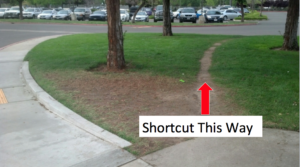Special Cases - Squares
Learning Outcomes
- Factor special products
 Some people find it helpful to know when they can take a shortcut to avoid doing extra work. There are some polynomials that will always factor a certain way, and for those, we offer a shortcut. Most people find it helpful to memorize the factored form of a perfect square trinomial or a difference of squares. The most important skill you will use in this section will be recognizing when you can use the shortcuts.
Some people find it helpful to know when they can take a shortcut to avoid doing extra work. There are some polynomials that will always factor a certain way, and for those, we offer a shortcut. Most people find it helpful to memorize the factored form of a perfect square trinomial or a difference of squares. The most important skill you will use in this section will be recognizing when you can use the shortcuts.
Factoring a Perfect Square Trinomial
A perfect square trinomial is a trinomial that can be written as the square of a binomial. Recall that when a binomial is squared, the result is the square of the first term added to twice the product of the two terms and the square of the last term.A General Note: Perfect Square Trinomials
A perfect square trinomial can be written as the square of a binomial:Example
Factor [latex]25{x}^{2}+20x+4[/latex].Answer: First, notice that [latex]25{x}^{2}[/latex] and [latex]4[/latex] are perfect squares because [latex]25{x}^{2}={\left(5x\right)}^{2}[/latex] and [latex]4={2}^{2}[/latex]. This means that [latex]a=5x\text{ and }b=2[/latex] Next, check to see if the middle term is equal to [latex]2ab[/latex], which it is:
[latex]2ab = 2\left(5x\right)\left(2\right)=20x[/latex]
Therefore, the trinomial is a perfect square trinomial and can be written as [latex]{\left(a+b\right)}^{2}={\left(5x+2\right)}^{2}[/latex].Example
Factor [latex]49{x}^{2}-14x+1[/latex].Answer: First, notice that [latex]49{x}^{2}[/latex] and [latex]1[/latex] are perfect squares because [latex]49{x}^{2}={\left(7x\right)}^{2}[/latex] and [latex]1={1}^{2}[/latex]. This means that [latex]a=7x[/latex] and [latex]b=1[/latex]. Next, check to see if the middle term is equal to [latex]2ab[/latex], which it is:
[latex]2ab = 2\left(7x\right)\left(1\right)=14x[/latex]
Therefore, the trinomial is a perfect square trinomial and can be written as [latex]{\left(a-b\right)}^{2}={\left(7x-1\right)}^{2}[/latex].How To: Given a perfect square trinomial, factor it into the square of a binomial
- Confirm that the first and last term are perfect squares.
- Confirm that the middle term is twice the product of [latex]ab[/latex].
- Write the factored form as [latex]{\left(a+b\right)}^{2}[/latex] or [latex]{\left(a-b\right)}^{2}[/latex].
Factoring a Difference of Squares
A difference of squares is a perfect square subtracted from a perfect square. Recall that a difference of squares can be rewritten as factors containing the same terms but opposite signs because the middle terms cancel each other out when the two factors are multiplied.A General Note: Differences of Squares
A difference of squares can be rewritten as two factors containing the same terms but opposite signs.Example
Factor [latex]9{x}^{2}-25[/latex].Answer: Notice that [latex]9{x}^{2}[/latex] and [latex]25[/latex] are perfect squares because [latex]9{x}^{2}={\left(3x\right)}^{2}[/latex] and [latex]25={5}^{2}[/latex]. This means that [latex]a=3x,\text{ and }b=5[/latex] The polynomial represents a difference of squares and can be rewritten as [latex]\left(3x+5\right)\left(3x - 5\right)[/latex]. Check that you are correct by multiplying. [latex-display]\left(3x+5\right)\left(3x - 5\right)=9x^2-15x+15x-25=9x^2-25[/latex-display]
Example
Factor [latex]81{y}^{2}-144[/latex].Answer: Notice that [latex]81{y}^{2}[/latex] and [latex]144[/latex] are perfect squares because [latex]81{y}^{2}={\left(9x\right)}^{2}[/latex] and [latex]144={12}^{2}[/latex]. This means that [latex]a=9x,\text{ and }b=12[/latex] The polynomial represents a difference of squares and can be rewritten as [latex]\left(9x+12\right)\left(9x - 12\right)[/latex]. Check that you are correct by multiplying. [latex-display]\left(9x+12\right)\left(9x - 12\right)=81x^2-108x+108x-144=81x^2-144[/latex-display]
How To: Given a difference of squares, factor it into binomials
- Confirm that the first and last term are perfect squares.
- Write the factored form as [latex]\left(a+b\right)\left(a-b\right)[/latex].
Think About It
Is there a formula to factor the sum of squares, [latex]a^2+b^2[/latex], into a product of two binomials? Write down some ideas for how you would answer this in the box below before you look at the answer. [practice-area rows="1"][/practice-area]Answer: There is no way to factor a sum of squares into a product of two binomials. This is because of addition - the middle term needs to "disappear" and the only way to do that is with opposite signs. To get a positive result, you must multiply two numbers with the same signs. The only time a sum of squares can be factored is if they share any common factors, as in the following case: [latex-display]9x^2+36[/latex-display] The only way to factor this expression is by pulling out the GCF which is 9. [latex-display]9x^2+36=9(x^2+4)[/latex-display]
Licenses & Attributions
CC licensed content, Original
- Screenshot: Method to the Madness. Provided by: Lumen Learning License: CC BY: Attribution.
- Image: Shortcut This Way. Provided by: Lumen Learning License: CC BY: Attribution.
- Revision and Adaptation. Provided by: Lumen Learning License: CC BY: Attribution.
CC licensed content, Shared previously
- Factor Perfect Square Trinomials Using a Formula. Authored by: James Sousa (Mathispower4u.com) for Lumen Learning. License: CC BY: Attribution.
- Ex: Factor a Difference of Squares. Authored by: James Sousa (Mathispower4u.com). License: CC BY: Attribution.
- Unit 12: Factoring, from Developmental Math: An Open Program. Provided by: Monterey Institute of Technology and Education Located at: https://www.nroc.org/. License: CC BY: Attribution.
